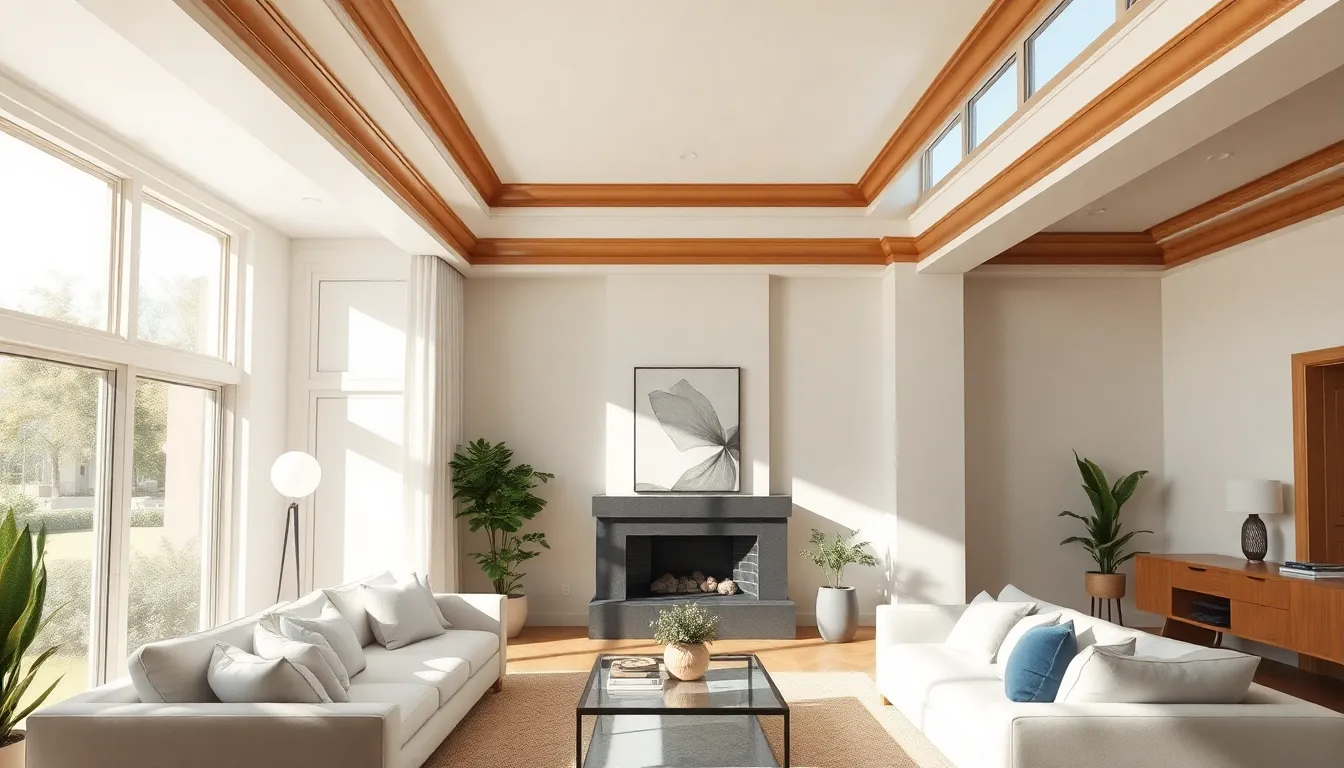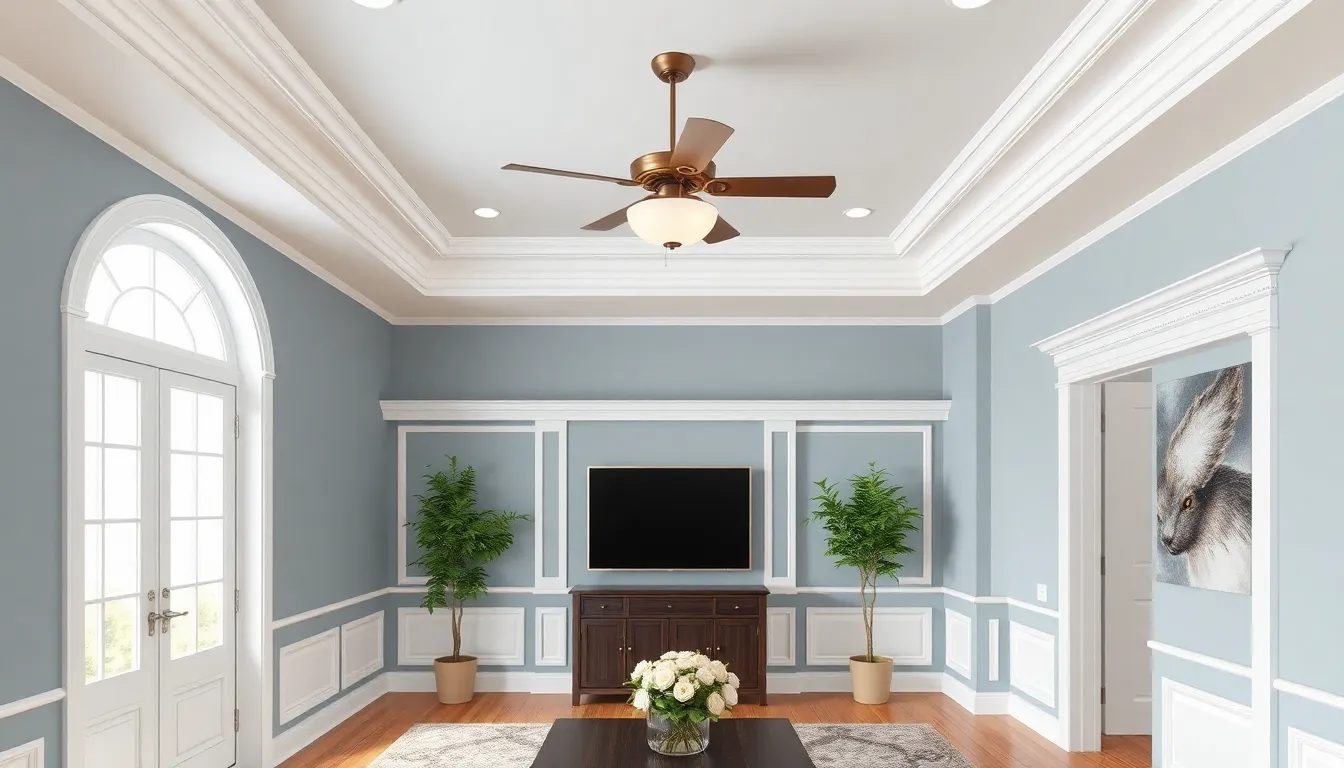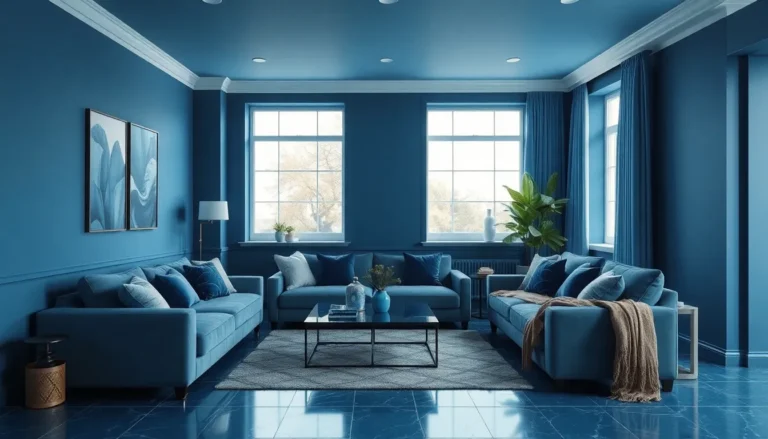Table of Contents
ToggleCeiling molding styles might not be the first thing that pops into your head when you think of home decor, but they can transform a bland ceiling into a work of art faster than you can say “crown jewel.” Imagine walking into a room where the ceiling doesn’t just sit there like a boring old hat but instead makes a bold statement. That’s the magic of molding!
Overview of Ceiling Molding Styles
Ceiling molding styles play a crucial role in defining a room’s character. Various styles exist to complement different interior designs. Traditional crown molding, for instance, features an elegant curve that enhances classic decor.
Coffered ceilings offer a bold, geometric appearance, adding depth and visual interest. This style divides the ceiling into grids, creating a structured look that can elevate the space.
Flat band molding provides a sleek, modern touch, maintaining clean lines and simplicity. This option works well in contemporary settings, where minimalism is prioritized.
Cove molding creates a soft, rounded transition between the wall and ceiling, promoting a seamless flow. It suits spaces aiming for a softer aesthetic, helping to soften harsh angles.
Beams, often wooden, introduce a rustic or industrial flair. They can serve as a focal point, drawing the eye upward, especially in high-ceilinged rooms.
Box beams, distinguished by their square design, add a three-dimensional effect. These moldings impart sophistication and can create a dramatic statement in any room.
Panel molding allows control over various ceiling heights and can be used to create visual boundaries. This versatile option can be tailored to fit any design style.
Each ceiling molding style offers unique advantages, enabling home decorators to personalize their spaces. By carefully selecting the molding, an individual can effectively enhance a room’s overall aesthetic and functionality.
Popular Ceiling Molding Styles
Ceiling molding comes in various styles, each offering unique visual appeal and functionality. Understanding these styles enhances decor choices and creates personalized spaces.
Crown Molding
Crown molding adds elegance and sophistication to ceilings. Typically, it features a rounded or angled profile, transitioning seamlessly from wall to ceiling. This style works well in traditional and modern settings, creating a sense of height in a room. Homeowners often choose intricate designs for formal areas or simpler profiles for more casual spaces. Many materials like wood, plaster, or polyurethane suit crown molding applications.
Baseboard Molding
Baseboard molding serves both practical and decorative functions. Positioned at the bottom of a wall, it protects against scuffs while enhancing the room’s aesthetic. Styles vary from simple and sleek to ornate and detailed. Choosing the right baseboard height impacts the overall design, with taller boards often creating a more dramatic look. Many homeowners paint baseboards to match or contrast with wall colors, adding to their visual interest.
Chair Rail Molding
Chair rail molding adds a unique touch to interior spaces. This style installs horizontally along walls, typically at chair height, protecting surfaces from damage. Designers often use it to separate wall colors or textures, enhancing room dynamics. Many styles, including traditional and contemporary designs, exist for chair rails, allowing customization. When combined with other moldings, chair rails can significantly enhance the overall room design.
Materials Used in Ceiling Molding
Different materials play distinct roles in ceiling molding, influencing aesthetics and durability. Key options include wood, MDF, and polystyrene.
Wood
Wood offers timeless beauty and versatility in ceiling molding. Many homeowners choose hardwood for its rich textures and natural grain patterns. Different wood types, such as oak, maple, and cherry, provide various finishes to match interior decor. Each wood species brings a unique character to the space, enhancing warmth and elegance. Additionally, wood molding can be stained or painted, offering flexibility for customization.
MDF
MDF, or medium-density fiberboard, serves as an affordable and practical alternative to wood. This engineered product boasts a smooth finish, allowing for precise paint applications without visible seams. Many people appreciate MDF’s resistance to warping, making it suitable for high-humidity areas. Various styles can be manufactured, ranging from simple designs to intricate patterns. MDF also provides an eco-friendly option, as it uses recycled materials.
Polystyrene
Polystyrene is lightweight and easy to handle, making it a popular choice for ceiling molding. Many homeowners enjoy polystyrene for its cost-effectiveness combined with the appearance of more expensive materials. Its foam structure allows for quick installation and minimal maintenance. Various styles and designs are available, giving decorators the freedom to choose options that fit their vision. Additionally, this material can be painted, offering further customization possibilities.
Choosing the Right Ceiling Molding Style
Selecting the appropriate ceiling molding style significantly enhances a room’s overall aesthetic. Start by considering the decor theme of the space. Traditional crown molding suits classic environments, adding elegance and sophistication. For those looking to make a bold statement, coffered ceilings present a geometric design, generating depth in high-ceilinged areas.
Contemporary styles often favor flat band molding, offering a sleek, modern appearance. This choice aligns well with minimalist interiors. Cove molding provides a gentle transition between wall and ceiling, creating a softer, more inviting atmosphere.
Rustic and industrial designs can benefit greatly from the introduction of wooden beams. These elements serve as captivating focal points, particularly in expansive rooms. Box beams enhance the environment’s sophistication by adding a three-dimensional effect that captivates the eye.
Assessing the practical functions of ceiling molding styles is also essential. Baseboard molding is multi-functional, protecting walls while contributing to visual appeal. Chair rail molding, installed at a specific height, protects surfaces while allowing for creative color or texture separation on walls.
Material selection will impact both aesthetics and durability. Wood boasts timeless beauty and versatility, with species like oak, maple, and cherry offering varied finishes. Emphasizing cost-effectiveness, MDF serves as a popular alternative due to its smooth finish and resistance to warping, suitable for areas with higher humidity.
Polystyrene stands out for its lightweight properties, ensuring quick installation and customization through paint. Each material has distinct benefits, enhancing the available choices for ceiling molding in any home decor project.
Installation Tips for Ceiling Molding
Ceiling molding installation requires careful planning and execution. Start by gathering essential tools such as a miter saw, level, adhesive, and finishing nails. Make measurements precise to ensure each piece fits well in place.
Choosing the right material influences handling. Wood requires precise cutting due to its density, while MDF offers easier manipulation. Consider how the chosen material affects both installation and final appearance.
Begin installation with the largest pieces of molding. Align them with the wall to maintain a clean, professional look. Use a level to confirm that the molding sits evenly along the ceiling.
Cutting molding at 45-degree angles creates seamless corners. This technique applies to both inside and outside corners, preventing gaps that detract from the visual appeal.
Applying adhesive to the back of the molding improves the bond to the ceiling and wall. In addition to adhesive, securing it with finishing nails adds stability.
Ensure to fill any nail holes or seams with caulk for a smooth finish. Sanding down rough edges before painting or staining enhances the final aesthetic.
Use paint or stain that complements the room’s decor. Opting for a semi-gloss finish reflects light and emphasizes detail, improving the overall design.
Estimating the amount of molding beforehand reduces waste. Calculate based on room dimensions, accounting for cuts and errors.
Completing the installation in a well-ventilated area makes the process more comfortable. Allow paint or adhesive to cure properly for lasting results. Following these tips creates stunning ceilings that elevate home interiors.
Conclusion
Ceiling molding styles offer a remarkable way to enhance any room’s aesthetic appeal. By selecting the right style and material, homeowners can create a unique atmosphere that reflects their personal taste. Whether opting for the timeless elegance of crown molding or the modern simplicity of flat band molding, each choice can dramatically transform a space.
Careful installation and attention to detail ensure that these decorative elements not only elevate the visual impact but also serve practical purposes. With various styles available, it’s easy to find the perfect fit for any decor theme. Embracing the versatility of ceiling molding can lead to stunning results that breathe new life into a home.








